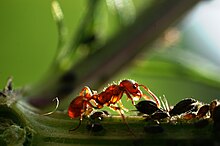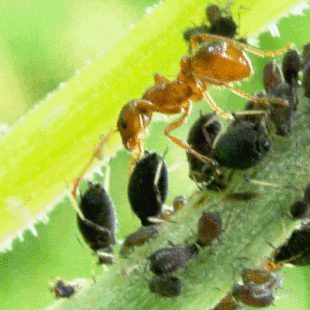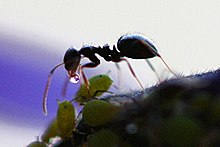Aphidophilia

Aphidophilia (Aphidoidea ' aphids ' and Greek φιλία philía 'affection') describes the ability of some species of different genera of ants (e.g. black garden ant ) to symbiosis with myrmecophilic beaked ants .
In principle, the term aphidophilia does not only refer to ants, other aphidophilic organisms could also represent plants that tolerate certain Schnabelkerfe (such as pemphigus spirothecae ). This can e.g. B. be the case with the formation of plant gall , some communities of Schnabelkerfen and host plant can give the appearance of a symbiosis.
The term aphidophilia is also applied to viruses that affect Schnabelkerfe. Common aphidophilic viruses e.g. B. in Hungary are: CMV, PVY, AMV and TSWV. In the following, however, aphidophilia is only related to ants.
The opposite of aphidophilia is aphidophagy . This denotes the adjustment and eating of Schnabelkerfen by predators and parasitoids .

Symbiosis form
The underlying form of symbiosis, named trophobiosis by E. Wasmann 1901/1902 , was described as early as the 17th century. It is about the relationship between myrmecophilic peckers, who offer food, and aphidophilic ants, who ingest this food and provide something in return (especially protection).
Role of ants
Some species of ants like the yellow meadow ant live exclusively (obligatory) on the sugary excretions of their Schnabelkerfe. Others use this food source as complementary food. In the symbiosis with Schnabelkerfen they can develop to a higher density, but they are usually more exposed to attacks by other ants and then less defensive.
Aphidophile ants can bring their aphids by anal Betrillern targeted to Honigtautopfen leave that can accommodate the ants directly. Usually a perianal fringe of hair is worked on by the ant. Aphidophilic ants can not only use the excreta of their trophobionts as a direct source of food, they can also increase the excretion rate (for example, twice).
Myrmecophile Schnabelkerfe let their ants carry them around. This is done, for example, to move them to a cheaper feeding place or when the ant burrow is relocated or to protect them from the weather or aphidophagia, for example. The aphidophilic ants protect their trophobionts against predators or parasitoids by attacking these animals directly or by carrying the Schnabelkerfe out of the danger zone.
Anatomical adaptation
To catch and collect the honeydew drops, some aphidophilic ants have developed a goiter. It is an anatomical trophobiotic device. In this hollow organ, the ant collects the nutritional fluid in order to partly consume it itself, but mostly to pass it on to other ants via trophallaxis .
Protective structures
Adult Schnabelkerfe or their eggs or larvae bring the ants to hibernate in specially reserved tempered underground chambers in the ant's nest, variously called "stable nests".
Some aphidophilic ants build special “pavilions” or “louse pavilions” ( English pavilion from French pavillon , from Latin papilio , butterfly, also “tent” in comparison with the open wings) as protective structures for ant guests .
The ants protect the root lice, which have settled close to the ground, from moisture loss in sunny places or from predators by covering deep branches above them with sand or earth crumbs, thus providing shelter.
As building material for the numerous single-chambered pavilions of your scale insects , Camponotus species such as C. (Karavaievia) asli sp. n., C. montanus sp. n. or C. texens also use the silk secretion of their ants larvae to protect the trophobionts from being blown by tree leaves. Brood and scale insects are usually housed there.
Role of Schnabelkerfe
Some also non-myrmecophilic Schnabelkerfe live socially in colonies and also fight off aphidophages together or with the help of a caste of soldiers. This social form of life favors coexistence with ants.
Many Hemiptera but honeydew from the sugary and especially fructose , glucose and sucrose contains (90-95% of dry matter), besides also come maltose , Fructomaltose and melezitose and other oligosaccharides in smaller amounts. This is done to reduce the volume, the sugar content of the sap is higher. The excreted honeydew is also used as a source of food by other (non-aphidophilic) animals without any symbiotic relationship, such as two-winged birds or honey bees . The latter produce forest honey from it .
Some Schnabelkerfe such as aphids, scale lice and root lice are myrmekophilic trophobionts, some are even dependent on aphidophilic ants (obligate myrmekophil). Some myrmecophilic aphids such as tuberolachnus can shed more honeydew in an hour than their own body weight can handle . The anal bristle ring, which is usually tricked by the ants and consists of an "upper" and a "lower" bristle stand, serves as a collecting device for the transfer of the honeydew drop to the ant. It is an anatomical trophobiotic device of myrmecophilic aphids.
| Taxa | Habitat | Myrmecophilia | credentials |
|---|---|---|---|
| Plant lice (Sternorrhyncha) | mostly above the ground | some types | |
| - "-: Aphids (Aphidoidea) | above the ground in plant crowns | some types | |
| - "-: Scale insects (Coccoidea) | above the ground | some types | |
| - "-: Tree lice (Lachnidae) | underground, on or above the ground in plant crowns | some types | |
| - "-: mealybugs (Pseudococcidae) | underground | some types | |
| Risso cicadas (Cicadomorpha) | |||
| - "-: Actalionidae | above the ground | Yes | |
| - "-: Cercopoidea | on the ground or underground | No | |
| - "-: Cicadoidea | underground | No | |
| - "-: dwarf cicadas (Cicadellidae) | above the ground | No | |
| - "-: Eurymelinae | underground, above or on the ground | some types | |
| - "-: Macropsinae | above the ground | some types | |
| - "-: Melizoderidae | ? | ? | |
| - "-: humpback chirps (Membracidae) | above the ground | Yes | |
| Pointed-head cicadas (Fulgoromorpha) | |||
| - "-: Acanaloniidae | above the ground | some types | |
| - "-: Achilidae | above the ground, under bark | No | |
| - "-: Achilixiidae | above the ground, under bark | No | |
| - "-: Glass-winged leaf hoppers (Cixiidae) | underground | some types | |
| - "-: Delphacidae Ugyopinî | above the ground in plant crowns | No | |
| - "-: Delphacidae Asiracini | above the ground in plant crowns | No | |
| - "-: other Delphacidae | above the ground in plant crowns | some species in pavilions | |
| - "-: Derbidae | above the ground, under bark | No | |
| - "-: Dictyopharidae | above the ground | No | |
| - "-: Eurybrachidae | above the ground | No | |
| - "-: Flatidae | above the ground | No | |
| - "-: Fulgoridae | above the ground | No | |
| - "-: Gengidae | ? | ? | |
| - "-: Hypochthonellidae | underground | in ant nests | |
| - "-: Beetle cicadas (Issidae) | Larvae underground, adults above the ground | some types | |
| - "-: Kinnaridae | underground | No | |
| - "-: Lophopidae | above the ground | No | |
| - "-: Meenoplidae | underground | No | |
| - "-: Nogodinidae | above the ground | No | |
| - "-: Ricaniidae | above the ground | No | |
| - "-: ant cicadas (Tettigometridae) | in, on or (mostly) above the floor | Larvae inside, adults predominantly outside of the ant nest | |
| - "-: Mosquitoes (Tropiduchidae) | above the ground | No | |
| Sheath beak (coleorrhyncha) | on the ground | No | |
| Bed bugs (heteroptera) | on the ground | not primary |
evolution
Aphidophilia has existed for at least 50 million years, this is how old the fossil of an ant trapped in amber is when it robs an aphid.
In 1987, CW Schaefer suspected that ants' aphidophilia was a very primeval form of life, but phylogenetic testing showed that mycophilia in Schnabelkerfen repeatedly developed independently of one another .
Individual evidence
- ↑ Z. Ilovai, I. Kajati, E. Kiss: Light oil based pesticides as to effective mean for IPM. (PDF) In: IOBC wprs Bulletin Volume 26, No. 3, 2003, pp. 183-187.
-
↑ Z. Ilovai, Cs. Budai, E. Dormanns-Simon, FE Kiss: Implementation of IPM in Hungarian greenhouses. In: IOBC wprs Bulletin 19, No. 1, 1996, pp. 63-66.
• EF Kiss: Virus diseases of greenhouse pepper in South Hungary. In: Proceedings of International Workshop on Biological and Integrated Pest Management in Greenhouse Pepper. Hódmezővásárhely, Hungary, 10. – 14. June 1996, pp. 119-131. - ↑ a b c d Manfred Hartbauer: Collective defense of Aphis nerii and Uroleucon hypochoeridis (Homoptera, Aphididae) against natural enemies. In: PLoS ONE 5, No. 4, April 29, 2010, e10417, doi: 10.1371 / journal.pone.0010417 .
- ↑ a b c d e Hans Schmidt: Morphology and ecology of the perianal hair ring of the aphids. In: Zeitschrift für Morphologie und Ökologie der Tiere 41, No. 2, 1952, pp. 223–246.
- ↑ K. Escherich: The relationships of the ants to non-social animals. In: K. Escherich (Ed.): Die Ameise , Eighth Chapter, Friedr. Viehweg & Sohn, Braunschweig 1917. S. 230ff.
- ↑ a b c B. Holldobler, EO Wilson: Journey to the Ants. The Belknap Press of Harvard University Press, Cambridge, Massachusetts 1994.
- ↑ Ants and forest costume. (PDF) (No longer available online.) Bavarian State Institute for Viticulture and Horticulture, October 8, 2009, archived from the original on March 26, 2010 ; Retrieved April 29, 2011 . Info: The archive link was inserted automatically and has not yet been checked. Please check the original and archive link according to the instructions and then remove this notice.
- ↑ Hartwig Kunkel: The excrement of aphids (Aphidina, Hemiptera) under the influence of ants. (PDF) In: Bonn zool. Contribution, Issue 1/2, No. 24, 1973, pp. 105–121.
- ^ CJ Banks, HL Nixon: Effects of the ant, Lasius niger L., on the feeding and excretion of the bean aphid, Aphis fabae Scop. In: Journal of Experimental Biology 35, No. 4, 1958, pp. 703-711.
- ↑ U. Maschwitz , J. Moog, A. Weissflog: Resource use of arborikoler ant communities in Southeast Asia: Diversity-preserving mechanisms. In: H. Dalitz, M. Haverkamp, SW Breckle: Abstracts for the DFG final symposium "Mechanisms of maintaining tropical diversity". Published by the Department of Ecology, Bielefeld University, Bielefeld 1992, p. 42.
- ^ A b c Jacques HC Delabie: Trophobiosis between Formicidae and Hemiptera (Sternorrhyncha and Auchenorrhyncha): an overview. In: Neotropical Entomology , Volume 30, No. 4, 2001, doi: 10.1590 / S1519-566X2001000400001 .
- ↑ a b c d e Andreas Weißflog: Free nesting of ants (Hymenoptera: Formicidae) in the crown region of humid tropical forests in Southeast Asia. (PDF) Dissertation at the Department of Biology and Computer Science, JW Goethe University in Frankfurt am Main, 2001.
- ↑ a b M. Dill: Wandering Shepherds. Ethoecological and taxonomic studies of a symbiosis complex of ants of the genus Dolichoderus and pseudococcids in Southeast Asia . Dissertation at the Department of Biology, JW Goethe University, Frankfurt am Main, 1996.
- ↑ Duden: Pavilion . Accessed January 28, 2015.
- ↑ M. Gibernau, A. Dejean: Ant protection of a Heteropteran trophobiont against a parasitoid wasp. In: Oecologia , Vol. 126, No. 1, 2001, pp. 53-57. doi : 10.1007 / s004420000479 .
- ^ C. Liefke, WHO Dorow, B. Hölldobler, U. Maschwitz: Nesting and food resources of syntopic species of the ant genus Polyrhachis (Hymenoptera, Formicidae) in West Malaysia. In: Insectes Sociaux , Vol. 45, No. 4, 1998, pp. 411-425. doi : 10.1007 / s000400050098 .
- ↑ Klaus Dumpert, Ulrich Maschwitz, Wolfgang Nässig, Wolfgang Dorow: Camponotus (Karavaievia) asli sp. n. and C. (K.) montanus sp. п., two weaver ant species from Malaysia (Formicidae: Formicinae). (PDF) In: Zool. Contribution NF , Vol. 32, No. 2, 1989, pp. 217-231.
- ↑ Ulrich Maschwitz, Klaus Dumpert, Gesche Schmidt: Silk pavilions of two Camponotus (Karavaievia) species from Malaysia: Description of a new nesting type in ants (Formicidae: Formicinae)). In: Zeitschrift für Tierpsychologie , Volume 69, No. 3, 1985, pp. 237-249. doi : 10.1111 / j.1439-0310.1985.tb00149.x .
- ↑ a b c d e f g h i j k l m n o p q r s t u v w x y z aa ab ac ad ae af ag ah Thierry Bourgoin: Habitat and ant-attendance in Hemiptera: a phylogenetic test with emphasis on trophobiosis in Fulgoromorpha. (PDF) In: P. Grandcolas (Ed.): The Origin of Biodiversity in Insects: Phylogenetic Tests of Evolutionary Scenarios. In: Mém. Mus. natn. Hist. nat. 173, Paris 1997, ISBN 2-85653-508-9 , pp. 109-129.
- ↑ Wolfgang Weitschat: Hunters, the hunted, parasites and stowaways - snapshots from the amber forest. In: Denisia 26, Neue Serie 86, pp. 243-256, Linz 2009.

